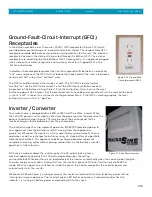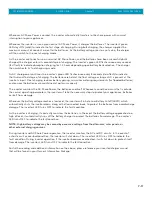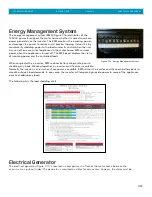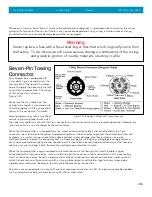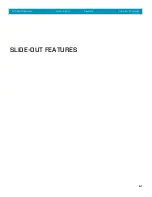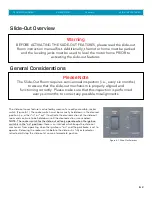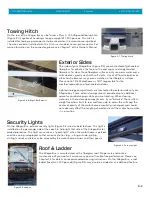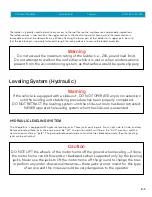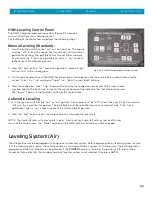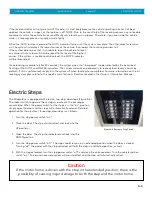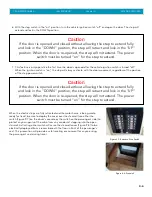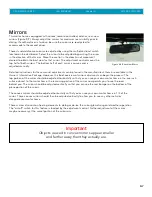
TIFFIN MOTORHOMES
–ALLEGRO BUS®
Chapter 7
ELECTRICAL FEATURES
Whenever AC Shore Power is sensed, the inverter automatically transfers to the shore power with minimal
interruption to your appliances.
Whenever the inverter is running on nominal AC Shore Power, it charges the batteries. The inverter’s green
LED stays ON (solid) to indicate the first stage of charging. During bulk charging, the charger supplies the
maximum amount of constant current to the batteries. As the battery voltage rises to a set value, the charger
will then switch to the next charging mode.
As the inverter continues to run on nominal AC Shore Power, and the batteries have been successfully bulk
charged, the charger enters its second stage of charging. The inverter’s green LED flashes once every second
(fast flash) to indicate absorption charging for 1-3 hours depending upon battery bank selection. The charger
then switches to its final chagrining mode.
As AC shore power continues the inverter’s green LED flashes once every 8 seconds (slow flash) to indicate
the third and final stage of charging. The batteries are held at the float voltage as long as AC is present at the
inverter’s input. Float charging reduces battery gassing, minimizes watering requirements (for flooded batteries)
and ensures the batteries are maintained at optimum capacity.
The inverter monitors the AC Shore Power, the batteries and itself. Whenever a condition occurs that is outside
the normal operating parameters, the inverter will take the necessary steps to protect your appliances, batteries
or itself from damage.
Whenever the battery voltage reaches a low level, the inverter will initiate Low Battery Cutoff (LBCO) which
automatically shuts the inverter down, along with all connected loads, to protect the batteries from overdischarge
damage. The inverter’s LED turns OFF to indicate the fault condition.
As the inverter is charging, it constantly monitors the batteries. In the event the battery voltage approaches too
high of level, it automatically turns off the battery charger to protect the batteries from damage. The inverter’s
LED turns OFF to indicate the fault condition.
NOTE: High battery voltage may be caused by excessive voltage from the alternator, solar panels, or
other external charging sources.
During inverter and AC Shore Power operation, the inverter monitors the AC and DC circuits. In the event of
a short-circuit or overload condition, the inverter will shut down. The inverter’s LED turns OFF to indicate the
fault condition. During inverter operation, if the inverter becomes overheated, it will shut down to protect itself
from damage. The inverter’s LED turns OFF to indicate the fault condition.
For further reading and additional information on the above, please reference your inverter/charger manual
that will be found in your Owner’s Information Package.
7-11
Summary of Contents for 2014 Allegro Bus
Page 6: ... TIFFIN MOTORHOMES ALLEGRO BUS Chapter 1 GENERAL INFORMATION GENERAL INFORMATION 1 1 ...
Page 51: ... TIFFIN MOTORHOMES ALLEGRO BUS Chapter 5 CABINETS FURNITURE CABINETS FURNITURE 5 1 ...
Page 55: ... TIFFIN MOTORHOMES ALLEGRO BUS Chapter 6 STRUCTURAL FEATURES STRUCTURAL FEATURES 6 1 ...
Page 57: ... TIFFIN MOTORHOMES ALLEGRO BUS Chapter 7 ELECTRICAL FEATURES ELECTRICAL FEATURES 7 1 ...
Page 72: ... TIFFIN MOTORHOMES ALLEGRO BUS Chapter 8 SLIDE OUT FEATURES SLIDE OUT FEATURES 8 1 ...
Page 76: ... TIFFIN MOTORHOMES ALLEGRO BUS Chapter 9 EXTERIOR FEATURES EXTERIOR FEATURES 9 1 ...
Page 83: ... TIFFIN MOTORHOMES ALLEGRO BUS Chapter 10 INTERIOR FEATURES INTERIOR FEATURES 10 1 ...
Page 87: ... TIFFIN MOTORHOMES ALLEGRO BUS Chapter 11 PLUMBING BATH FIXTURES PLUMBING BATH FIXTURES 11 1 ...
Page 105: ... TIFFIN MOTORHOMES ALLEGRO BUS Chapter 13 ROUTINE MAINTENANCE ROUTINE MAINTENANCE 13 1 ...














